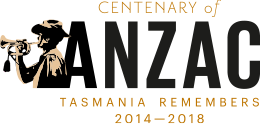Commemorative Garden
Grant recipient: Derwent Valley Council
Grant received: $3,200
Cross of sacrifice
The New Norfolk Cenotaph is a sandstone “Cross of Sacrifice” some six metres high, situated at the top end of High Street, New Norfolk. Funded by public subscription, it was unveiled by General Sir John Gellibrand in August 1922. The monument originally commemorated the 416 men and three nurses from the area who served in World War I. Seventy of those people made the supreme sacrifice and did not return home. The memorial now also pays homage to those who served in World War II, the Korean War, the Malayan Emergency, the Indonesian Confrontation and the Vietnam Wars. Adjacent to the Cenotaph is a memorial to the Boer War, which originally served as a functioning drinking fountain on the High St and Stephen St corner of Arthur Square.
Until 1930, New Norfolk’s ANZAC Day services were commemorated in local churches, with wreaths moved to the Cenotaph afterwards. In that year it was decided that the monument itself would be a more fitting place to hold the service. The first Dawn Service was held in 1953 and the New Norfolk War Memorial Hall opened in 1954.
The Cenotaph continues to provide a focal point for the community. ANZAC Day services are always well attended and Remembrance Day ceremonies have attracted a growing number of participants. Standing directly in front of the Derwent Valley Council Chambers, the Cenotaph attracts a great deal of interest from visitors to the area, who also take the opportunity to read the nearby history storyboard. It seemed fitting that any further commemoration of World War I would also be in this civic precinct, building on the existing memorials and encouraging people to stop and wander through the town.
Commemorative Garden
The ANZAC Commemorative Garden and interpretation panel is the result of collaboration between the Derwent Valley Council, the New Norfolk Sub-Branch of the RSL and New Norfolk Historical Information Centre. Its purpose is to honour the service of those who served in World War I. A disused garden bed was redeveloped and planted with “Peace” and “Centenary of ANZAC” roses as a fitting commemoration to the sacrifice of those in World War I. The project also involved the installation of an interpretive storyboard detailing the history of Millbrook Rise Psychopathic Hospital.
Millbrook Rise
Millbrook Rise was opened in February 1934 by the then Governor of Tasmania, Sir Ernest Clark. It was built using funds from the British Red Cross Society and the Order of St John, which was awarded to the State after the armistice of 1918. It was primarily for the treatment of “shell shocked” veterans of World War I and their families, but later became a more general psychiatric facility. Bench seats have been installed in and near the rose garden, providing a place for quiet contemplation.
During the Centenary of Anzac, information has been printed about Millbrook Rise. (PDF)
Community proud of its heritage
The ANZAC Commemorative Garden has been well received by the community as a fitting redevelopment of the area. The community of the Derwent Valley is very proud of its heritage, including those who have served in many conflicts and peacekeeping activities over the years. This project gave the community an opportunity to recognise the sacrifices of those who served and helps to provide a focal point for the community during commemorations.
The Derwent Valley Council would like to thank the Tasmanian Government, New Norfolk RSL Sub-Branch, Mr Ken O’Brien OAM, New Norfolk Historical Information Centre and the Army Museum of Tasmania for their assistance in completing this project.


